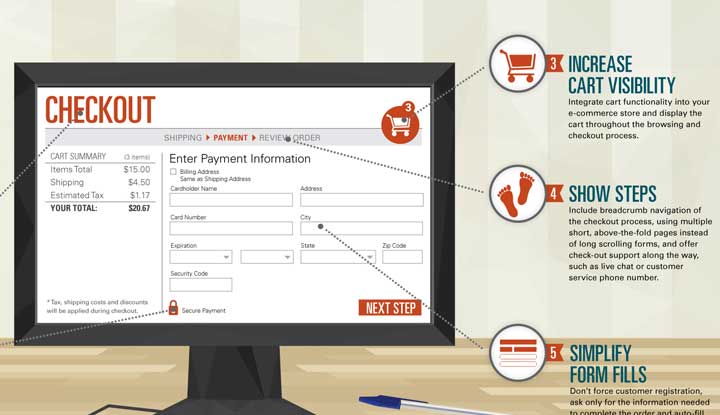Competitive e-commerce business owners are always considering how to boost online sales. More often than not, the biggest problem lies in guiding online visitors through the buying process (or purchase path). From content on product pages to the parting message given to customers, all of these small details impact conversion rates (i.e., the percentage of users who take a desired action).
Here is a look at five e-commerce tips that will improve your conversation rates and capture more sales.
-
Product Pages
I’d wager that you are selling quality products or you won’t be in businesses very long. However, it is just a matter of presenting products in a way that is appealing to online shoppers. Product pages are where visitors ultimately make their decision to buy or not; so make sure you’re convincing.
For starters, provide high quality product shots; snapshots at different angles. Allow users to click on an image to zoom in. Take it a step further by recording videos of your product in use (when applicable). Naturally, ensure your product page includes compelling copy. This page is where customers receive the bulk of product information.
Keep in mind: don’t make exaggerated claims; stick to the facts. It’s a good idea to offer two versions of product descriptions – one that is concise and another that is more detailed.
-
Call to Action
Just because online visitors visit your product page doesn’t mean they will spend their money. Your website needs a little help by the way of a call to action (CTA) (i.e., attention grabbing buttons and messages). To accomplish this, consider how your CTA buttons look. They should stand out from the rest of the page. Meanwhile, it is not recommended that you litter the page with them, to avoid clutter. Next, use verbs to prompt action; keep it simple and short. Lastly, ensure CTA’s are positioned where they are immediately visible — above the fold.
-
Landing Pages
When online visitors “land” on your website it is generally due to them clicking on an external ad or via search engine results page. However, nothing is more frustrating than following a promo link only to find an irrelevant landing page that has nothing to do with the reason why a visitor decided to click in the first place. So, take a good look at your PPC campaigns and link to appropriate landing pages on your website for continuity.
As for the landing pages themselves, keep the layout easy to navigate. Provide important information there and lead them to a CTA button. Your content should share exact benefits and verbiage such as “limited time offer” is known to communicate urgency. Lastly, earn their trust by placing testimonials, customer reviews, and social proof directly on each landing page.
-
Checkout Pages
Once an online visitor clicks the “Add To Cart” button your job has just begun. At this point, your website should guide that customer through a seamless and user friendly checkout process to reduce cart abandonment. So, don’t bombard customers with surveys or links to other products and pages at this point; minimize distractions.
Make the checkout form easy to follow. Label each data field clearly, and provide examples to lessen confusion. It doesn’t hurt to visually show steps necessary to complete the purchase by using a progress bar at the top of every page. Also give customers the option to go back to previous pages without having to clear entire checkout forms. Meanwhile, reiterate important purchase information before the transaction is complete — including products purchased, costs, methods of delivery, etc.
One of the biggest mistakes e-commerce companies make is to require visitors to register for an account at checkout. An Econsultancy survey suggests that a “key barrier to purchase is compulsory registration [(making people register before they can make a purchase)], something which would make 26% of respondents abandon the shopping basket.” Lastly, assure customers that your website is safe by using a secure server and prominently displaying security trust marks. Customers expect their data to be protected.
-
Thank You Page
When an online customer makes a purchase that is great, but it’s not enough. Following checkout, you should provide a thank you page to follow-up and capture more conversions. First, don’t leave customers in the dark. Confirm that the transaction was successful and provide any information that will dissuade apprehensions including confirmation emails or text messages and links to tracking updates when possible. Then provide contact details and steps they should take in case something goes wrong.
This is also a good time to offer incentives and promotions since these customers have already given you their trust and expressed interest. Offer related products or ask for email newsletter sign ups. Take advantage of their good experience and also ask them to share their great finds with friends via prominently placed social media buttons.
There’s always something more that we can do to increase our online businesses’ conversion rate. It’s a matter of having the utmost respect for our products and their quality, and tailoring the entire purchasing experience for the convenience of the customer before, during, and after the transaction.
This article has been edited and condensed.
Harlon Agsaoay is a web content blogger, philosophy graduate, accomplished musician, small business entrepreneur, and was once a contributor for a defunct local newspaper in the Philippines. He is currently a contributor for websites like Lifehack and Firepole Marketing. His interests include nature tripping, musical exploration, food, basketball, and literature.
© YFS Magazine. All Rights Reserved. Copying prohibited. All material is protected by U.S. and international copyright laws. Unauthorized reproduction or distribution of this material is prohibited. Sharing of this material under Attribution-NonCommercial-NoDerivatives 4.0 International terms, listed here, is permitted.













